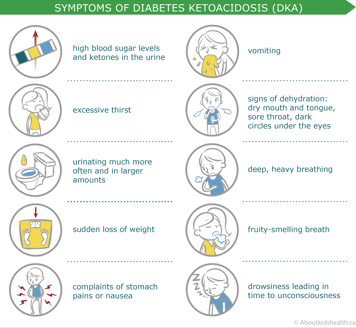Diabetic ketoacidosis (DKA) is life threatening, but preventable. DKA develops when there is a serious lack of insulin in the body.
What is diabetic ketoacidosis?
A serious lack of insulin may occur:
- at the time of diagnosis; about 10 per cent to 67 per cent of children newly diagnosed with diabetes end up in the emergency room with DKA
- when the child is not taking enough insulin on a regular basis; parents are encouraged to remain involved in supporting and supervising their children with injections long into their adolescent years
- when hyperglycemia and accompanying symptoms are not addressed in a timely manner
- when the body is under stress due to illness, caused by an infection such as the flu. An illness may create a demand for more insulin than normal. Failure to meet the increase in insulin needs and correctly adjust insulin doses may result in DKA.
When there is not enough insulin available, blood sugar levels rise and excess sugar spills into the urine. Then the body starts breaking down fat as an alternative supply of energy. The ketones produced by fat breakdown are acidic, causing ketoacidosis. As the condition worsens, and more and more water is lost in the urine and through vomiting, the child becomes increasingly dehydrated. DKA can be avoided by careful attention to all aspects of the diabetes treatment plan. DKA usually develops over hours or days.
Symptoms of DKA
If a child exhibits any of the following signs, blood sugar level and ketones in the urine should be checked:

If you suspected DKA, tell the doctor right away. DKA must be treated in hospital.
How to do a urine sugar and ketone test
Urinary ketones are checked by dipping a chemically treated strip in a fresh sample of urine. Strips are available at your local pharmacy. When you dip a ketone strip into the urine, the strip will change colour. Each colour represents the amount of ketones in the urine (none, small, medium or large amount).
Ketones are a sign that too much fat has broken down in the body, caused by either too little insulin or the stress of illness on the body.
Check urinary ketones when:
- blood sugar levels are more than 14 mmol/L
- your child is feeling ill, has a fever, or has vomited
- your child has symptoms of high blood sugar, such as increased thirst and urination.
Have strips at home for ketone checking at all times. Make sure that the strips have not expired by checking the expiration date on the bottle. The bottle should be kept closed.
How to take a urine ketone test:
- Collect the urine in any clean container.
- Take one ketone test strip out of its package.
- Dip the square test at the end of the test strip into the urine.
- Dip the end of the strip in the urine. Make sure the urine covers the whole testing area.
- Wait for the recommended period of time before reading the ketone test strip.
- Compare the colours in the testing area with the colours on the test strip package to determine if ketones are present in the urine.